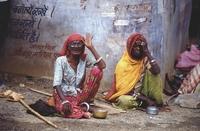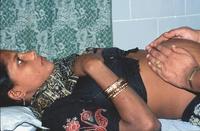Black days Bhopalos

According to a report prepared by the BBC in 2004, the population of Bhopal suffers various diseases. The rate of cancer and tuberculosis is 4 times higher than the average in the country and that of abortions 7 times higher. Among other diseases, they include: genetic defects, serious problems with the rule, advance of menopause, lack of coordination, memory loss, partial blindness, paralysis, poor immune system... The list of diseases can be long, too long. In addition, in the following generations effects are also observed: children are lower, have less skull and many are born with shape anomalies.
Accident?
Among the toxic substances released from a tank were hydrogen cyanide and methyl isocyanate, one of the most lethal substances known. According to studies, a ton of water was introduced into the methyl isocyanate tank due to a defective valve. Methyl isocyanate reacts violently when mixed with water, causing a very toxic cloud that night. None of the security measures contained in the building worked, and the reason, according to New Scientist magazine, was "Bhopal's very poor emergency equipment," "much more limited than the company's building in the United States."
The pesticide plant was designed to produce 5,250 tons per year, but in 1983 it stood at 1,657 tons. To cope with annual losses (4-5 million dollars), the management of Unión Carbide decided to reduce costs and reduce security and personnel measures. He never designed an emergency plan.
Bhopallo was a factory that did not comply at all with safety and environmental measures. Multinational and Government of India, both conscious. Can you call it an accident?

After the disaster
Union Carbide left the factory shortly after the disaster and 21 years later remains unaccountable. The Government of India negotiated an economic agreement with Union Carbide in 1989. The company paid 470 million dollars, between 370 and 533 dollars per victim (403-581 euros). With this money you can pay medical expenses of 5 years, but many of the patients have health problems until the end of their life. Currently Union Carbide is owned by the multinational Dow Chemical, but does not want to assume any responsibility.
The worst, that there are still many toxic substances in the building environment. Its waters and lands are polluted and several people eat and drink from there. According to samples taken by Greenpeace, in the underground water wells near the factories, the level of chlorinated substances of difficult degradation is high, and heavy metals are also found in the water. Not only in water, but also in breast milk.
Damage extends to the next generations. Cleaning the area is absolutely necessary, but Dow Chemical, the new owner of the company, does not want to know anything, the special technology to use seems to be quite expensive.
Beyond the bhopato

The case of Bhopal is very popular, but in the world there are between 1 and 5 million annual poisons and several deaths from pesticides.
Since the disaster, December 3 was declared World Day against Insecticides. However, the fight to win goes beyond the use of pesticides. If such disasters are to be avoided, it is absolutely necessary to establish universal human rights legislation that directly affects businesses. That is, to force man to respect us.





